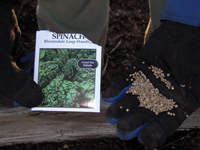
Seeds are like tiny treasure chests loaded with riches for your garden.
Seeds are little marvels. If someone needs proof of miracles, have them plant a tiny carrot seed and then harvest a fat carrot weeks later. Or sow a gritty morning glory seed and watch throughout the season as it rambles over a chain-link fence, producing an electric display. Or let them plant a typical-looking sunflower seed and then crane their neck to look at a plate-sized flower towering over 10 feet tall. The potential locked inside seeds is awe-inspiring and humbling.
Seeds are basically dormant plant embryos usually enclosed within an outer shell. They come in all shapes and sizes -- from massive double coconuts (up to 40 pounds) to dust-like begonia seeds. Some seeds, like tomatoes and kiwis, are enclosed in pulpy fruits; while others, like bladderwort and hollyhocks, are surrounded by dry husks. Most coniferous trees hold their naked seeds in cones, while many hardwood trees protect their seeds inside tough hulls, as with Brazil nut, hickory, and Kentucky coffee tree. Many seeds not only contain nourishment (the endosperm) for the developing plant embryos, but we can use them for food, too. Wheat, corn, peanuts, soybeans, rice, pine nuts, pecans, and cashews are some of the seeds we enjoy.
As we approach spring, gardeners buy seeds by the thousands. With preparation, skill, and a little luck, those seeds will become millions of flowers and fruits later in the year.

These seedlings have plenty of elbow room, thanks to diligent thinning.
Here are a few general rules to follow:
In cold climates, warm-weather plants that are susceptible to late frosts and easy to transplant can be sown indoors now. Tomatoes, peppers, moss roses, and pansies are good examples of plants that will have a jump on the growing season if started indoors. Be sure to thoroughly clean all containers. Sit them on a waterproof tray and fill with sterilized germination mix. Sow seeds at the depth recommended on the seed packet, or twice as deep as the seed diameter.
Place containers and trays under fluorescent lights or in a sunny area, and cover with a clear lid to retain moisture. Keep them at about 70 degrees, unless otherwise noted on the seed packet. After the plants sprout, thin them accordingly. If possible, fill the waterproof tray with water and let it soak into the soil from the bottom. Wet foliage can lead to fatal diseases like damping off. Once plants have two sets of true leaves and the frost date has passed, carefully transplant them into the garden.
Lettuce, okra, peas, pumpkins, spinach, beets, zucchini, beans, carrots, nasturtiums, coneflowers, and hellebores are just a few of the good candidates for outdoor sowing. Also, plants with taproots are best sown outdoors where they will grow because the taproot can be easily damaged during transplanting. For best performance, remember to thin seedlings early. Thinnings from crops like field greens and beans can be used in salads and garnishes.
Rake the surface of the soil so it's loose and friable. It is not necessary to sow crops in rows, but it makes maintenance easier. Annual and perennial seed can be arranged or simply scattered for a more natural look.

Sow spinach seeds as early as the soil can be worked.
Starting plants from seeds is a great family activity. It's quality time together in the sunshine and fresh air. The kids will learn invaluable life lessons, plus their springy muscles are made for stooping and bending.
Germinating seeds teaches kids responsibility, cause and effect, observation, measuring, and weather patterns. Make a simple chart that includes data such as seed variety, planting date, watering schedule, weather report (if planted outside), germination date, height, number of true leaves, etc. They can use the chart to monitor the progress of their plants. Help the children use spacing recommendations to thin the seedlings. With assistance, they can develop a system (height, number of leaves, date, other signs) to determine when seedlings are ready to transplant into the garden.
Sowing seeds is one of the most fundamental and rewarding tasks in gardening. The journey from inanimate speck of debris to vibrant flora is an incredible process even for the most grizzled veterans. So gather your materials and plant some miracles.